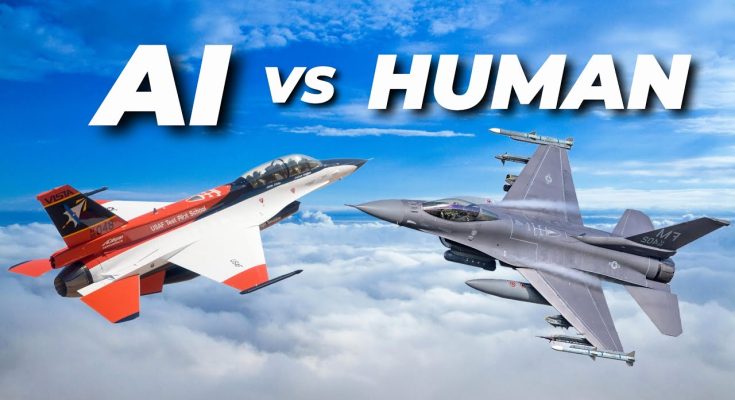In a significant leap forward in military aviation, the X-62A VISTA (Variable In-flight Simulation Test Aircraft) has taken center stage, ushering in the era of AI-controlled fighter jets engaging in dogfights alongside human pilots. This groundbreaking development marks a pivotal moment in the integration of artificial intelligence (AI) into combat aviation, as the U.S. Air Force explores the full potential of AI in high-intensity, real-time aerial combat.
What Is the X-62A VISTA?
The X-62A VISTA is a technology demonstrator developed by the U.S. Air Force and Lockheed Martin. It is designed to test and evaluate the capabilities of AI in controlling aircraft autonomously, particularly in complex aerial combat scenarios. Unlike traditional fighter jets, which rely on human pilots to make split-second decisions in combat, the X-62A is capable of making decisions independently, based on real-time data gathered from its sensors and the surrounding environment. The aircraft can autonomously execute advanced maneuvers, respond to enemy movements, and adapt to dynamic combat situations without direct human input.
The X-62A serves as a testbed for new technologies that could one day revolutionize air combat, including autonomous flight systems, AI-assisted decision-making, and machine learning algorithms that can make aircraft more agile and effective in the skies. Its development is part of the Air Force’s broader effort to explore the integration of AI into various aspects of military operations, from logistics to direct combat.
AI Versus Human Pilots: The Dogfight Challenge
The most exciting aspect of the X-62A VISTA’s development is its participation in dogfight simulations with human pilots. These exercises pit the AI-controlled X-62A against manned aircraft, often putting the two in a high-stakes, high-speed aerial battle. The idea is to observe how well AI can adapt to the unpredictable nature of real-world air combat and whether it can match or even surpass the abilities of human pilots.
During these dogfight simulations, the X-62A is tasked with performing maneuvers and making combat decisions on the fly, just like a human pilot. The AI system is designed to assess the tactical environment, calculate the best course of action, and execute complex aerial strategies with incredible precision. Its ability to react instantly to the evolving dynamics of the dogfight allows it to compete with human pilots who might be limited by reaction time, fatigue, or the inherent cognitive load of decision-making in such intense situations.
While human pilots are still far from obsolete, the AI-controlled X-62A showcases how artificial intelligence could eventually become a co-pilot or even take over some combat tasks entirely. In these tests, the AI is trained to learn and adapt from each encounter, gradually improving its performance and potentially outmaneuvering a human opponent.
The Impact of AI in Combat Aviation
The integration of AI into fighter jets such as the X-62A offers several key advantages. For one, AI has the capability to perform split-second decision-making based on vast amounts of data, something human pilots are inherently limited by. With the ability to process information much faster than the human brain, AI can execute maneuvers and countermeasures that might be too quick or complex for a human pilot to execute.
Moreover, AI-controlled jets like the X-62A can be used in scenarios where human pilots would otherwise be at risk, such as high-altitude, high-stress combat zones. By delegating some combat tasks to AI, human pilots could focus on mission-critical aspects like strategy, target prioritization, and coordination with other units. Additionally, AI offers the potential for unmanned fighter jets, which could reduce the risks to human life in dangerous missions, such as deep penetration strikes or air superiority operations in contested airspace.
Another critical benefit is training. AI-controlled aircraft can simulate a wide variety of opponents, enabling pilots to face more diverse and challenging scenarios during training. With AI as a training tool, human pilots can engage in repeated dogfights against an evolving enemy, helping to hone their skills in ways that were previously unimaginable.
Future of AI-Controlled Fighter Jets
While the X-62A VISTA is still in its testing phase, the success of this program could lay the groundwork for future autonomous air combat systems. The ultimate goal is not to replace human pilots entirely but to create a synergy between human intelligence and machine intelligence that can outpace adversaries in dynamic combat environments.
The AI systems powering fighter jets like the X-62A could be implemented alongside traditional human-piloted aircraft, allowing for hybrid combat forces that maximize the strengths of both. In this future scenario, AI could serve as a force multiplier, coordinating airstrikes, acting as a co-pilot, or even managing entire fleets of unmanned combat aircraft.
However, there are challenges ahead. Ethical concerns, trust in AI systems, and ensuring that human pilots can effectively interact with autonomous platforms will require ongoing development and testing. Additionally, AI-based systems need to be highly secure to prevent hacking or malfunctions that could compromise mission success.
Conclusion
The X-62A VISTA is a groundbreaking step forward in the world of AI-controlled aviation and represents the beginning of a new era in aerial warfare. As AI continues to evolve, fighter jets like the X-62A will play a critical role in revolutionizing combat tactics, making air forces more effective, efficient, and adaptive. By testing AI’s ability to engage in real-time dogfights with human pilots, the U.S. Air Force is setting the stage for a future where human and machine work together to dominate the skies. While there’s still much to learn, one thing is clear: the future of air combat will be shaped by the partnership between AI and human pilots, leading to faster, smarter, and more precise military operations.



